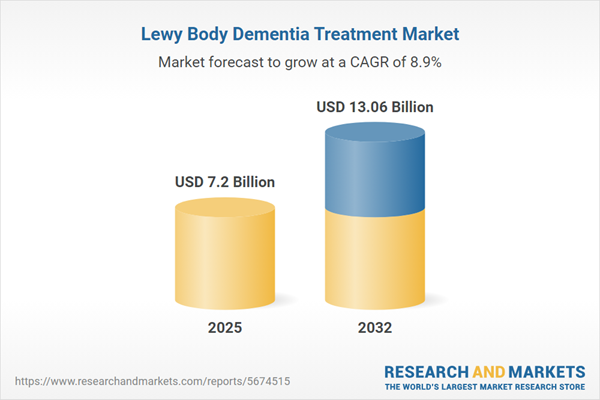Speak directly to the analyst to clarify any post sales queries you may have.
Senior decision-makers in the Lewy Body Dementia Treatment Market face a landscape shaped by evolving therapies, rapid technological integration, and shifting regulatory demands. Adaptive, evidence-based strategies are essential for navigating care delivery and aligning business priorities for long-term growth and competitive resilience.
Market Snapshot: Lewy Body Dementia Treatment Market Size and Growth
The Lewy Body Dementia Treatment Market is projected to reach USD 7.20 billion in 2025, increasing from USD 6.60 billion in 2024, with a compound annual growth rate (CAGR) of 8.89%. Expansion in this sector is propelled by significant advances in neurological treatment options, wider utilization of sophisticated diagnostic tools, and a shift toward integrated models of patient care. Leading companies are sharpening their focus on rapid product development, service differentiation, and strategic agility in response to increasing competition and evolving care needs. Senior leaders are prioritizing evidence-based resource allocations to address both clinical and commercial shifts influencing the broader treatment ecosystem.
Scope & Segmentation: Lewy Body Dementia Treatment Market
Understanding key market segments and their operational implications enables organizations to focus resources efficiently, ensuring relevant and impactful decision-making in diverse clinical and commercial settings.
- Treatment Modality: Spans options including cholinesterase inhibitors, various pharmacological therapies, and non-drug strategies such as cognitive and physical rehabilitation, each tailored to specific care requirements and patient profiles.
- Distribution Channel: Encompasses hospital-based systems, retail pharmacies, and digital pharmacy platforms. Selection of distribution channels directly influences therapy accessibility and strategic logistical planning.
- End User: Involves application through hospitals, specialized clinics, and home care models. Enhanced understanding of end-user preferences and infrastructure supports targeted workforce and resource deployment.
- Route of Administration: Covers oral, intravenous, and transdermal methods, supporting personalized and flexible care delivery to improve patient adherence and engagement.
- Treatment Line: Integrates first-, second-, and third-line therapies, fostering adaptable treatment planning across various stages of disease progression.
- Region: Includes the Americas, Europe, Middle East & Africa, and Asia-Pacific. Each region reflects distinct payment structures, care regulations, and healthcare infrastructure, which shape tailored go-to-market and compliance strategies.
- Key Companies: Highlights established players including Eisai Co., Ltd., Biogen Inc., Novartis AG, Eli Lilly and Company, Pfizer Inc., Roche Holding AG, H. Lundbeck A/S, UCB Pharma S.A., ACADIA Pharmaceuticals Inc., and Axovant Sciences Ltd. Their market actions drive cross-sector partnerships and innovations that underpin value creation.
Key Takeaways for Senior Decision-Makers
- Investments in neuroimaging and advanced diagnostic technologies are facilitating cross-functional collaboration, leading to more informed clinical decisions and improved patient outcomes.
- Deployment of virtual health platforms and wearable monitoring technologies is expanding reach, enabling both remote and on-site care and supporting ongoing patient management.
- Adoption of precision medicine is supporting highly tailored treatment strategies, which can improve care quality for diverse patient segments.
- Strategic collaboration among pharmaceutical and biotechnology firms is accelerating product pipelines, fostering rapid response to emerging therapeutic needs.
- Close monitoring of evolving regulatory standards and reimbursement policies is necessary to sustain operational continuity and manage exposure to compliance risks.
- Integration between medical and behavioral healthcare is resulting in a more coordinated approach, providing early intervention opportunities for changing patient needs.
Tariff Impact on Supply Chain Reliability and Pricing
Anticipated changes in United States tariffs for 2025 are driving organizations in this market to strengthen sourcing diversity, validate procurement protocols, and enhance risk management. By adopting these measures, senior executives are reinforcing supply chain resilience and maintaining consistent delivery of pharmaceutical products and patient care, despite potential regulatory changes and price volatility.
Methodology & Data Sources
This analysis is based on structured interviews with clinicians and researchers, comprehensive literature review, and assessment of current regulatory frameworks. Ongoing engagement with industry leaders and continuous tracking of market movements support delivery of actionable intelligence for executive-level decisions.
Why This Report Matters for Senior Decision-Makers
- Delivers actionable market intelligence for improved strategic resource deployment and data-driven risk assessment.
- Enables prompt adaptation to advancements in technology and regulatory dynamics, supporting sustained operational effectiveness.
- Provides recommendations for procurement and supplier strategies, helping foster robust supply chain operations amid market uncertainties.
Conclusion
In an evolving healthcare environment, access to reliable insights equips senior executives to develop adaptive strategies, strengthen organizational resilience, and align clinical and commercial operations to ongoing shifts in the Lewy Body Dementia Treatment Market.
Additional Product Information:
- Purchase of this report includes 1 year online access with quarterly updates.
- This report can be updated on request. Please contact our Customer Experience team using the Ask a Question widget on our website.
Table of Contents
3. Executive Summary
4. Market Overview
7. Cumulative Impact of Artificial Intelligence 2025
Companies Mentioned
The companies profiled in this Lewy Body Dementia Treatment market report include:- Eisai Co., Ltd.
- Biogen Inc.
- Novartis AG
- Eli Lilly and Company
- Pfizer Inc.
- Roche Holding AG
- H. Lundbeck A/S
- UCB Pharma S.A.
- ACADIA Pharmaceuticals Inc.
- Axovant Sciences Ltd.
Table Information
| Report Attribute | Details |
|---|---|
| No. of Pages | 184 |
| Published | November 2025 |
| Forecast Period | 2025 - 2032 |
| Estimated Market Value ( USD | $ 7.2 Billion |
| Forecasted Market Value ( USD | $ 13.06 Billion |
| Compound Annual Growth Rate | 8.8% |
| Regions Covered | Global |
| No. of Companies Mentioned | 11 |









